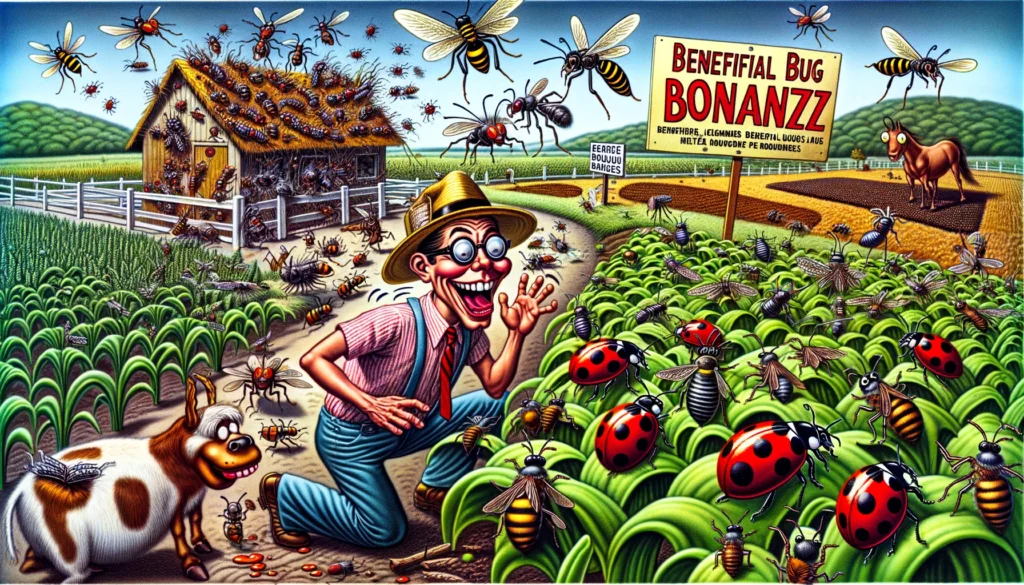
Beneficial Bugs A satirical illustration in the style of Mad Magazine titled Beneficial Bugs. The scene shows a farmer enthusiastically releasing beneficial bugs li.webp.webp
Beneficial Bug Blunders
The Hilarious Highs and Lows of Letting Bugs Run the Farm!”
Green Acres, USA – In the thriving agricultural community of Green Acres, USA, farmers are discovering that introducing beneficial bugs to their farms can be an adventure filled with laughter and lessons. As they embrace these natural pest control methods, their stories reveal a mix of triumphs and hilarious mishaps, proving that even the best intentions can sometimes go awry.
Ladybug Invasion
Farmer Jeff Walters decided to introduce ladybugs to combat aphids naturally. “I thought they’d handle the pests quietly,” he recalls. Instead, the ladybugs multiplied rapidly, turning his farm into a ladybug paradise. “It was like a scene from a horror movie, but with ladybugs,” he laughs. Entomologist Bug Buster advises, “Releasing ladybugs in moderation can prevent an overwhelming population.”

Bee Battle
To boost pollination, Farmer Sally brought in bees, expecting improved crop yields. What she didn’t anticipate was an excess of honey. “We had more honey than we knew what to do with,” she chuckles. The unintended surplus led to a sweet but sticky situation. “Manage bee populations to balance pollination and honey production,” suggests Apiarist Buzz Keeper.

Mantis Mayhem
Farmer Tom released praying mantises to control garden pests, but they preferred lounging around instead of hunting. “They were more like garden ornaments,” he jokes. The mantis mayhem underscored the importance of monitoring released insects. “Ensure beneficial insects are active and effective,” advises Biological Control Specialist Green Guardian.

Worm Wonders
Adding earthworms to enrich the soil seemed like a great idea to Farmer Jane, until she noticed they had migrated to her neighbor’s yard. “I guess they found better soil next door,” she sighs. The worm wonders highlighted the need for proper habitat creation. “Create an inviting environment for beneficial worms,” says Soil Scientist Terra Firma.
Butterfly Bonanza
Introducing butterflies for pollination turned into a distraction for farmhands at Farmer Bob’s place. “They spent more time chasing butterflies than working,” he laughs. The butterfly bonanza was a beautiful yet disruptive addition. “Butterflies are best in controlled garden areas,” notes Horticulturist Flora Bloom.
Ant Agony
Using ants to manage pests seemed ingenious to Farmer Ed, until they found their way into his kitchen. “I never thought I’d have ants on my breakfast table,” he groans. The ant agony taught him the importance of placement. “Ants need to be kept away from living areas,” advises Pest Control Expert Natural Guard.
Dragonfly Drama
Bringing in dragonflies for mosquito control led to swarms around Farmer Tom’s pond. “They were beautiful, but they took over the pond,” he says. The dragonfly drama underscored the need for balanced ecosystems. “Ensure introduced species don’t overwhelm local habitats,” advises Ecologist Aqua Stream.
Spider Snafus
Farmer Jane released spiders to control flies, but they built webs everywhere but the fields. “It was like Halloween all year round,” she laughs. The spider snafu highlighted the unpredictability of natural pest control. “Position spiders strategically for effective fly control,” suggests Arachnologist Web Weaver.
Beetle Bust
Introducing beetles to manage weeds backfired for Farmer Bob when the beetles started eating his crops. “They had a feast,” he recalls. The beetle bust emphasized the importance of species selection. “Choose beetle species that target weeds, not crops,” advises Entomologist Green Thumb.
Fly Frenzy
Using fly predators to control flies led to an unexpected barn invasion at Farmer Ed’s farm. “They stayed in the barn and ignored the fields,” he sighs. The fly frenzy taught him the importance of distribution. “Disperse fly predators evenly across the farm,” advises Pest Control Specialist Swat Team.
Cricket Chaos
Introducing crickets for soil aeration turned into a nightly symphony at Farmer Jeff’s farm. “It was like living in a concert hall,” he chuckles. The cricket chaos was a melodic yet disruptive addition. “Control cricket populations to balance benefits and noise,” advises Agricultural Entomologist Chirp Note.
Lacewing Lunacy
Farmer Sally released lacewings to combat aphids, but they were more interested in her farm’s lights. “They swarmed every lightbulb,” she laughs. The lacewing lunacy highlighted the need for strategic placement. “Release lacewings away from artificial lights,” advises Insect Specialist Glow Worm.
Roly-Poly Rampage
Adding pill bugs to decompose organic matter led to an unexpected invasion of Farmer Bob’s farmhouse. “They were everywhere,” he groans. The roly-poly rampage taught him the importance of containment. “Keep decomposers in designated compost areas,” advises Soil Health Expert Decompose Right.
Hoverfly Havoc
Introducing hoverflies for pollination turned lunch breaks into a nuisance at Farmer Jane’s farm. “They wouldn’t leave us alone,” she sighs. The hoverfly havoc emphasized the need for managing insect interactions. “Place hoverfly habitats away from human activity areas,” advises Pollination Expert Flower Power.
Mosquito Muddle
Releasing mosquito fish to control mosquitoes in his pond led Farmer Tom to discover they migrated to every water source available. “Even the birdbath wasn’t safe,” he laughs. The mosquito muddle underscored the need for monitoring aquatic species. “Ensure mosquito fish are confined to intended areas,” advises Aquatic Specialist Splash Wave.
As the farmers of Green Acres, USA, continue their adventures with beneficial bugs, they find humor in their missteps and share valuable lessons with one another. The community’s collective wisdom and wit ensure that their farms, and their spirits, remain resilient and thriving.
Helpful Content for Farmers
Step-by-Step Guides
- How to Avoid Ladybug Invasions:
- Step 1: Release ladybugs in moderation to prevent overpopulation.
- Step 2: Monitor ladybug activity to ensure they are effective.
- Pro Tips for Bee Management:
- Tip 1: Balance bee populations to match your pollination needs.
- Tip 2: Manage honey production to avoid excess.
- Insider Knowledge on Releasing Beneficial Insects:
- Insider Tip: Ensure beneficial insects are placed in appropriate environments.
- Expert Insight: Monitor and adjust populations as needed.
Disclaimer
This article is the result of a highly sophisticated collaboration between a cowboy and a farmer, entirely devoid of any artificial intelligence interference. Any resemblance to real beneficial bug blunders is purely coincidental, albeit hilariously accurate.
15 Educational Observations
- Ladybug Invasion: Introducing ladybugs for aphid control leads to a farm overrun with ladybugs.
- Bee Battle: Bringing in bees for pollination results in an unintended honey surplus.
- Mantis Mayhem: Releasing praying mantises that prefer lounging on the porch rather than hunting pests.
- Worm Wonders: Adding earthworms to enrich the soil, only to find they’ve migrated to the neighbor’s yard.
- Butterfly Bonanza: Introducing butterflies for pollination that end up distracting farmhands.
- Ant Agony: Using ants to control pests, but they end up in the farmhouse kitchen.
- Dragonfly Drama: Bringing in dragonflies for mosquito control, only to have them swarm the farm pond.
- Spider Snafus: Releasing spiders to catch flies, but they build webs everywhere but the fields.
- Beetle Bust: Introducing beetles to manage weeds, only to have them munch on the crops instead.
- Fly Frenzy: Using fly predators that decide to stay in the barn instead of the fields.
- Cricket Chaos: Introducing crickets for soil aeration, which leads to a symphony of night-time chirping.
- Lacewing Lunacy: Releasing lacewings that seem more interested in the farm’s lights than in eating pests.
- Roly-Poly Rampage: Adding pill bugs to decompose organic matter, only to find them invading the farmhouse.
- Hoverfly Havoc: Introducing hoverflies that become a nuisance during lunch breaks.
- Mosquito Muddle: Releasing mosquito fish for pond control, but they migrate to every water source available.
Originally posted 2016-03-26 19:48:49.
Originally Published at FarmerCowboy.com
2024-11-26 00:14:29
Karl Hoffman is a distinguished agriculturalist with over four decades of experience in sustainable farming practices. He holds a Ph.D. in Agronomy from Cornell University and has made significant contributions as a professor at Iowa State University. Hoffman’s groundbreaking research on integrated pest management and soil health has revolutionized modern agriculture. As a respected farm journalist, his column “Field Notes with Karl Hoffman” and his blog “The Modern Farmer” provide insightful, practical advice to a global audience. Hoffman’s work with the USDA and the United Nations FAO has enhanced food security worldwide. His awards include the USDA’s Distinguished Service Award and the World Food Prize, reflecting his profound impact on agriculture and sustainability.





Elon Musk vs. Asmongold — Tesla’s self-driving tech: turning commuting into the perfect opportunity to play games.